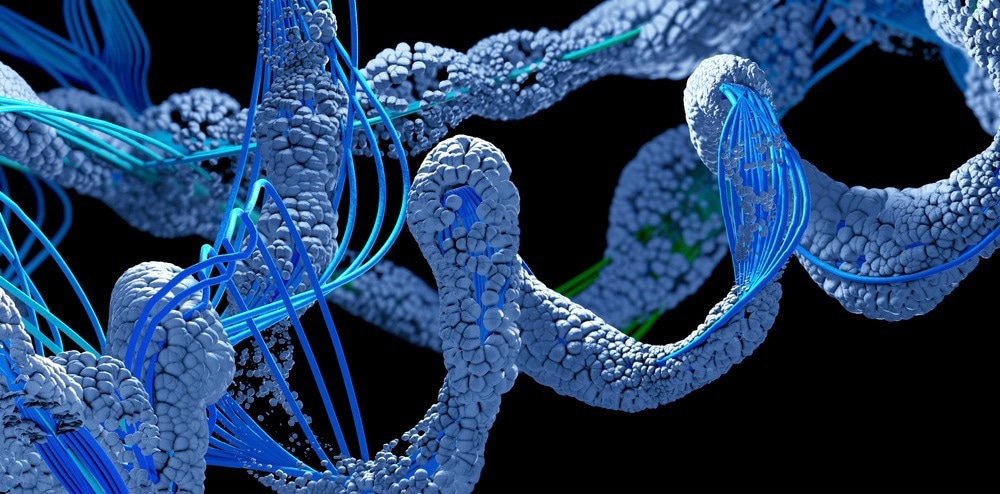Protein folding is integral for normal physiology, such as development and aging, which can be compromised with dysfunctional protein folding that can result in disease pathologies such as neurodegeneration and cancer.

Image Credit: Christoph Burgstedt/Shutterstock.com
This critical process consists of polypeptide chains being bound together in a particular sequence to form secondary structures known as αlpha-helices or βeta-sheets, which comprise the backbone and side chains of the molecule. This structure undergoes further folding to form tertiary structures through 3D folding of α-helices and β-sheets and many different molecular interactions with the globular structure. This can produce a unique protein shape and the final quaternary form.
The unique shape of proteins is critical to the structure and function of the protein, with significant biological implications. This is due to the protein structure being involved in every part of human biology, including channel proteins, receptors, binding sites, as well as interactions with other proteins for biological processes.
How can Protein Folding Can Impact Biology?
The successful folding of a protein can ensure the optimum functioning of proteins, and with 20,000 to 100,000 proteins in each cell, depending on the cell type, effective protein folding is significant for cellular function and efficiency.
However, when there is a mutation in a gene that encodes a protein, this can cause protein folding to be faulty and either be non-functional or cause malignancy, resulting in a multitude of diseases.
An example of a disease resulting from faulty protein folding includes cancer, with the disease occurrence and progression frequently rooted in a mutation at this core developmental stage.
One of the hallmarks of cancer consists of an abnormally high level of proliferation as well as migration, which is supported by metabolism and protein quality control. Cancerous cells demonstrate increased early production of polypeptides, increased mutations, and higher levels of reactive oxygen species (ROS), amongst other cellular environmental changes, which all challenge the protein folding process.
Additionally, cancer cells also depend highly on chaperone proteins, which are a group of proteins that are expressed in cells that have been exposed to higher temperatures or environmental stress. These proteins were initially identified as heat-shock proteins (Hsp) and have been theorized to have the ability to stabilize as well as facilitate protein refolding in proteins that were originally partially denatured through exposure to higher temperatures.
Protein folding explained
Interestingly, due to the dependence of cancerous cells on these proteins, Hsp70 and Hsp90 have been identified as drug targets for novel cancer therapeutics. This is significant as by targeting these proteins in cancer cells, drugs can be made to be more specific to cancer tissue, aiding in precise and effective treatment.
Protein Misfolding in Neurodegenerative Disorders
Other protein-misfolding disorders involving the accumulation of misfolded proteins can cause diseases, including amyloid diseases, frequently found in the neurodegenerative population.
Alzheimer's disease is the most prevalent amyloid disorder, affecting approximately 10% of North America's adult population over 65 years. Other neurodegenerative diseases include Parkinson's and Huntington's disease, which are similar in origin and can occur sporadically as well as through heritability. The risk of developing these neurodegenerative diseases increases with age as a result of a higher disruption in biological processes. This includes protein folding that causes the accumulation of the misfolded proteins that then form aggregates as a precursor.
Protein Misfolding in Non-Neurological Disorders
Protein misfolding can also occur in non-neurological diseases, with the presence of these mutations also being found in peripheral tissue. These amyloidogenic genes and protein products include but are not limited to type 2 diabetes, inherited cataracts, certain forms of atherosclerosis, as well as hemodialysis-related disorders.
The pattern of these disorders is similar, with proteins having an abnormal tendency to aggregate due to misfolding. Many underlying factors cause aggregation, including proteasome deficiencies, inhibited autophagy, and oxidative stress, and with more understanding of amyloid diseases, further research, and development of therapeutic interventions and treatments have been employed.
Future Outlook
Proteins are essential structural building blocks for all living things, and folding these molecules is significant for many diseases and disorders. With many of these diseases becoming more frequently diagnosed in the global population, including type 2 diabetes, as well as being rooted in more severe diseases such as cancer, research into drug targets that can aid in effective treatment and even prevention is critical.
The Human Proteome Project may be a stepping stone to understanding protein-related diseases more comprehensively, allowing for more targeted therapeutics to be undertaken with a more successful and effective result.
Last Updated: Jun 2, 2023